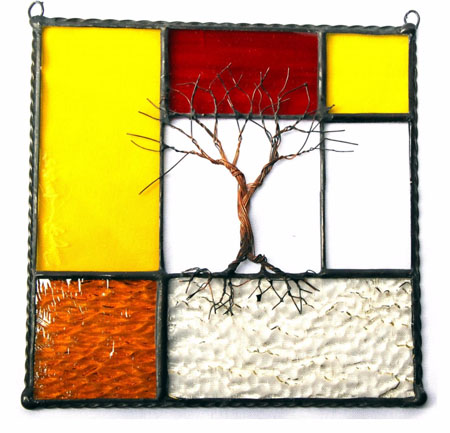Frog Hollow Craft Association and Gallery: Shining the Spotlight on Metal Artists in Vermont and Beyond
Founded in 1971, Frog Hollow Craft Association and Gallery was the first designated craft center in the country, helping launch the careers of several notable metalsmithing artists including Steven Bronstein, Kate Pond, and Mark Eliot Schwabe to name a few. This non-profit has come a long way in the past 40 years, outgrowing their original location on a sleepy side street in Middlebury and recently relocating to a much larger storefront on Church Street in Burlington.
In a state that boasts more artists and artisans per capita than anywhere else in the United States, Frog Hollow has remained a central force in Vermont arts and crafts culture.
 Stained glass and copper art by Terry Zigmund.
Stained glass and copper art by Terry Zigmund. Photograph courtesy of Frog Hollow Craft and Gallery.
“Our educational mission for our community sets us apart,” says Gallery Manager Meredith Mann. “We’re a nonprofit artist collective, and most galleries are not. We have outreach to teach people about the arts, so it’s important for us to reach beyond our retail environment and try to engage the community.”
In this respect, Frog Hollow has been successful to a degree few other galleries have been. Their unique focus on exclusively serving local Vermont artists and educating the community about art helps to build support and creativity within the community. Mann believes it’s all about maintaining a balance.
“We want to promote younger artists while still honoring the traditions and master artists we have,” he says. “It’s important to keep that balance and keep the craft culture in Vermont going strong.”
Mann says everyone inspires one another and keeps each other on their toes.
“Sometimes our younger artists don’t necessarily know the art world as well, and our master artists and craftsmen may be less familiar with things like social media and other forces that are changing the scene.”
To keep their craft culture alive, the artists and artisans that make up the Frog Hollow collective and gallery space select and support their fellow members. Membership in the artists collective and space in the gallery is determined democratically. Aside from emerging artist shows, like the “Fresh Perspective” show going up in April, artists wanting to show work in the gallery typically approach the collective with their work, go through a jury process, and, if selected, are given a month-long trial run with open critique and a final vote by the other members of the collective. “It’s not perfect, but it’s a democracy,” laughs Mann. “We have, at any given time, around 160 to 180 artists that are members of the organization, so everyone really helps everyone else out as much as they can, and the artists always give really great critiques and feedback.”
Throughout their storied history in Vermont arts and crafts culture, Frog Hollow has always made space for their metal artists, with a focus on copper, brass, and bronze.
“Copper artists Steven Bronstein and Kate Pond have been with Frog Hollow since the very beginning,” says Mann.
Artist John Black, a 2018 Frog Hollow Grant recipient, brings copper, silver and gold jewelry into the gallery space that’s contemporary, geometric, and chic. Artist Locklin Smith brings playful copper brass and silver creations that please all ages.
“Locklin’s work is very fun. His earrings aren’t in the case because he wants people to get up close with his pieces and see how they wear and move,” Mann says with an audible smile. Metalsmith Mark Eliot Schwabe creates jewelry with a retrofuturistic, pop culture-oriented flair, pulling inspiration from steampunk, old military gear, Game of Thrones and science fiction. His metal work can include anything from a $2000 brass and copper boat pin with moving parts to a $20 keychain.
The gallery also has a new spotlight space, for current work and retrospectives for artists not necessarily part of the collective. Currently, they are doing a retrospective on Vermont native and founding member Richard Wissler and his mother, featuring pieces of Wissler’s kinetic metal mobiles, ceramic and mixed ceramic-metal artwork.
With a robust group of artists like the members of Frog Hollow, copper and metal arts have a promising future in Vermont.
“I would like to see our organization thrive and continue to develop ways to inspire our youth to be artists, and our community to be kind and compassionate and work together through art,” reflects Mann.
Resources:
Also in this Issue:
- Arthur Carter: Geometry and Copper Collide
- Encountering the Buddha: Art and Practice Across Asia
- Foraging for Vera’s Iron and Vine
- Frog Hollow Craft Association and Gallery: Shining the Spotlight on Metal Artists in Vermont and Beyond
- Figurative Oils Merge with The Intrinsic Beauty of Oxidized Copper
